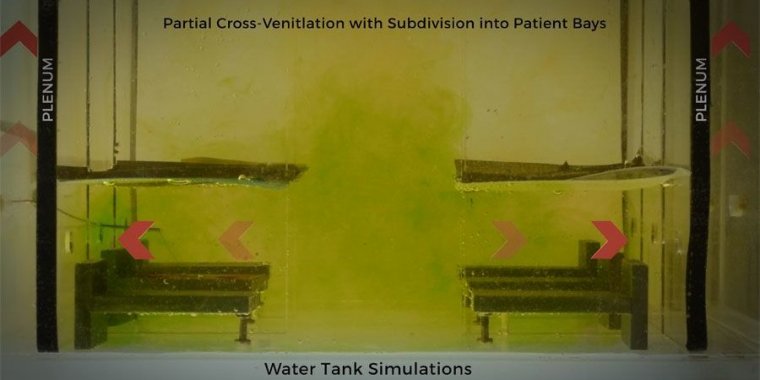| News / Science News |
Making safer emergency hospitals
Simple, low-cost ventilation designs and configuration of wards can reduce the dispersal of airborne virus in emergency COVID-19 hospitals.

Making safer emergency hospitals. Photo: University of Cambridge
The coronavirus pandemic is stressing bed space capacity in hospitals globally. Healthcare authorities are attempting to add thousands of additional bed spaces by temporarily adapting any available large open halls.
However, large air-conditioned halls tend to have top-down air-conditioning, which creates turbulent flows that can mix and spread droplets containing the virus very widely.
At six changes of the air in the occupied part of the hall in an hour, it may take over 20 minutes to dilute the concentration of smaller droplets produced in a cough to below a tenth of their original density.
This, say the researchers, is plenty of time for droplets to travel beyond 20m, putting healthcare professionals in particular at risk as they move about through “a slowly refreshing miasma”.
Professor Andrew Woods FRS of Cambridge’s BP Institute (BPI) and Professor Alan Short of the Department of Architecture have developed a series of practical solutions to reduce the concentration of airborne virus experienced by patients and healthcare workers in buildings converted into makeshift wards.
“Effective ventilation is critically important in helping to suppress cross-infection, and nowhere more so than in an infectious diseases ward,” says Short.
“Patients coughing or being ventilated will project droplets, some containing the virus, as an aerosol. They are so small that they may take tens of minutes to fall to the floor as the droplet evaporates in still air.”
The team’s recommendations are based on physical laboratory experiments to test ventilation systems for two basic arrangements of beds: what is becoming a standard approach of placing hundreds of beds in an open hall with low level partitions, compared with arranging beds within enclosed patient bays so that, as far as possible, the exhaust air does not permeate the rest of the hall.
In the completely open version, ventilation air moves down to the ground and spreads out over the patient beds, leading to a highly mixed environment.
When a patient coughs (red) or releases aerosols, the flow pattern of the aerosols can extend across the space to other patient beds, even to patients across the corridor.
In the version subdivided into patient bays, the ventilation flow (green) still comes down from the ceiling and moves into the patient bed-spaces and mixes, but a good proportion of this air is removed through exhaust ducts located behind the beds.
When a patient produces aerosols within a bay (orange), the aerosol concentration remains high in the bay and as air is drawn out through the exhaust duct this limits the aerosol transport into the main space.
“In a large hall, airflows mix up the airborne aerosols all too efficiently and disperse them through the space across patients and perhaps more significantly nurses and healthcare workers,” explains Woods. “A small measure, such as the installation of part-enclosed patient bays with exhaust ducts can help reduce this dispersion.” (University of Cambridge)
YOU MAY ALSO LIKE





